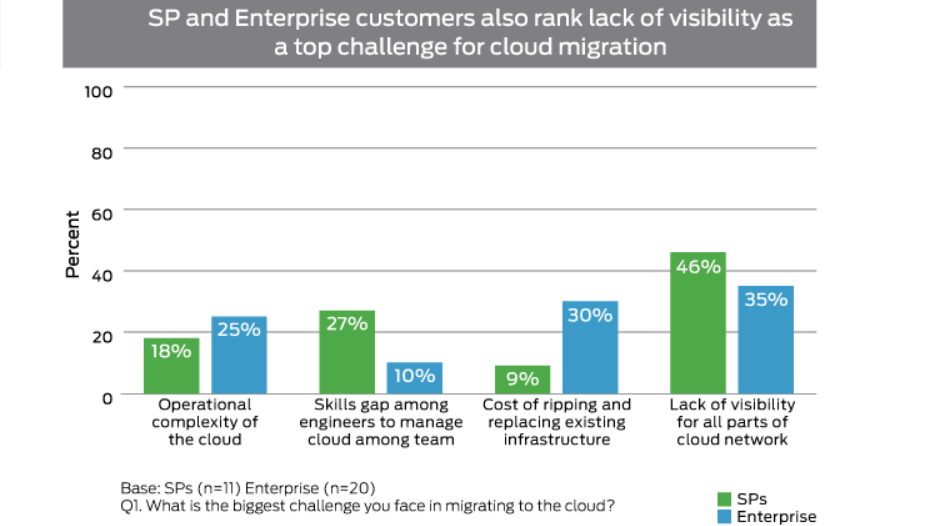
Distributed telecommunications cloud environments offer service providers a way to more quickly, efficiently and cost-effectively deliver services to end users, but they come with their share of complexity, management headaches, integration challenges and coordinating operations among multiple cloud vendors.
In a recent survey by Juniper Networks, service providers noted that a lack of visibility into all parts of the network cloud was the most difficult challenge facing as they migrate to the cloud, and that more than half of respondents said they use two or more cloud vendors in their distributed environments, adding to the complexity and the lack of visibility.
The networking vendor in 2013 stepped into the competitive software-defined networking (SDN) space when, a year after buying startup Contrail, launched its Contrail SDN controller and made it the foundation of its network virtualization efforts. It has since launched the Contrail Cloud, an integrated cloud platform that includes orchestration software for compute, storage, networking and management, and designed to enable telcos, mobile operators and cable providers to deploy high-performance clouds that leverage network-functions virtualization (NFV) technologies. Juniper this week is rolling out enhancements to Contrail Cloud that officials said are designed to address many of the challenges service providers face undergoing the transition from traditional infrastructure to the cloud.
The enhancements include integration of Red Hat’s OpenStack Platform and Ceph Storage software-defined storage (SDS) technology and the bundling of automation and visibility technologies from AppFormix – a company Juniper bought last year for cloud optimization services – and a range of pre-validated virtual network functions (VNF).
“Building and operating a distributed cloud is no easy task,” Mike Bushong, senior director of product marketing at Juniper, wrote in a post on the company blog. “Service providers have proven beyond a doubt that they can build out a network. But delivering dynamic services on a distributed cloud is more challenging. It involves multi-vendor software with cloud-tailored management and orchestration tools. This means that service providers must deliver new infrastructure, using new processes and even new skills that have traditionally not been part of the service provider DNA. Indeed, distributed cloud represents a transformation across all parts of the business and more than merely an infrastructure deployment. It’s a massive undertaking, requiring a financial and personnel commitment to complete the migration.”
To help with the migration, Juniper is expanding its collaboration with Red Hat by integrating the open source software maker’s OpenStack Platform for infrastructure-as-a-service (IaaS) and Ceph Storage with Contrail Cloud. That combined with the infrastructure monitoring capabilities of AppFormix are aimed at easing issues around interoperability and management, according to Pratik Roychowdhury, senior director of product management for Juniper’s Contrail business. The combination of Red Hat’s OpenStack Platform and Juniper’s Contrail SDN offering gives carriers a production-grade platform for delivering services, Roychowdhury wrote in a post on the company blog.
A key to telco migration to the cloud will be NFV, according to the Juniper officials. SDN is still gaining traction in the enterprise, but NFV is getting speedy adoption from carriers. Unlike SDN, which started as more of a vendor-driven effort, NFV was developed under the European Telecommunications Standards Institute (ESTI), which includes carriers and rolled out the first NFV paper in 2012. Analysts from IHS Markit are predicting that the NFV market will reach $36 billion by 2021. The same analysts a year ago said that by 2020, 80 percent of the money spent in the NFV space will go towards software rather than hardware. The numbers indicated that “that service providers are not just experimenting with, but rapidly preparing for, a distributed cloud driven by virtualized infrastructure,” Bushong wrote.
Roychowdhury said the latest enhancements of Contrail Cloud also include bundled pre-validated service stacks “containing service chains and supporting VNFs used to deliver cloud-enabled services, enabling operators to deploy tested NFV-enabled services on their infrastructure.” He added that Juniper is working with tech partners and other VNF vendor to create pre-validated deployment packages that will give carriers resources they can use to create virtual services that can be quickly deployed and perform well on the Contrail Cloud infrastructure. The platform supports such services as Juniper’s vSRX Virtual Firewall and Affirmed Networks’ Mobile Content Cloud virtual evolved packet core (vEPC) solution, and will include third-party VNFs.






Be the first to comment